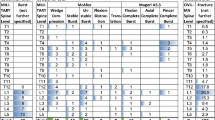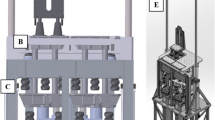Abstract
Fourteen simulated underbody blast impact sled tests were performed using a horizontal deceleration sled with the aim of evaluating the dynamic response of the spine in under various conditions. Conditions were characterized by input (peak velocity and time-to-peak velocity for the seat and floor), seat type (rigid or padded) and the presence of personnel protective equipment (PPE). A 50% (T12) and 30% (T8) reduction in the thoracic spine response for the specimens outfitted with PPE was observed. Longer duration seat pulses (55 ms) resulted in a 68–78% reduction in the magnitude of spine responses and a reduction in the injuries at the pelvis, thoracic and lumbar regions when compared to shorter seat pulses (10 ms). The trend analysis for the peak Z (caudal to cranial) acceleration measured along the spine showed a quadratic fit (p < 0.05), rejecting the hypothesis that the magnitude of the acceleration would decrease linearly as the load traveled caudal to cranial through the spine during an Underbody Blast (UBB) event. A UBB event occurs when an explosion beneath a vehicle propels the vehicle and its occupants vertically. Further analysis revealed a relationship (p < 0.01) between peak sacrum acceleration and peak spine accelerations measured at all levels. This study provides an initial analysis of the relationship between input conditions and spine response in a simulated underbody blast environment.




Similar content being viewed by others
References
Babu V., R. Thyagarajan and S. Arepally. Retractor-Based Stroking Seat System and Energy-Absorbing Floor to Mitigate High Shock and Vertical Acceleration. NATO/STO AVT-221 Specialists Meeting on “Design and Protection Technologies for Land and Amphibious NATO Vehicles”: TARDEC, 2014, p. 17.
Bailey, A. M., J. J. Christopher, F. Brozoski, and R. S. Salzar. Post mortem human surrogate injury response of the pelvis and lower extremities to simulated underbody blast. Ann. Biomed. Eng. 43:1907–1917, 2015.
Bailey A. M., J. J. Christopher, K. Henderson, F. Brozoski and R. Salzar. Comparison of Hybrid-III and PMHS Response to Simulated Underbody Blast Loading Conditions. In: Proceedings of IRCOBI Conference 2013.
Bosch K., K. Harris, J. Melotik, D. Clark and R. Scherer. Blast mitigation seat analysis: Drop tower data review. Booz-Allen and Hamilton Inc Troy MI Ground Systems Survivability, 2014.
Chubb, R. M., W. R. Detrick, and R. H. Shannon. Compression fractures of the spine during USAF ejections. Aerosp. Med. 36:968–972, 1965.
Danelson, K., L. Watkins, J. Hendricks, P. Frounfelker, W. I. C. R. Team, K. Pizzolato-Heine, R. Valentine, and K. Loftis. Analysis of the frequency and mechanism of injury to warfighters in the under-body blast environment. Stapp. Car Crash J. 62:489–513, 2018.
Danelson, K. A., A. R. Kemper, M. J. Mason, M. Tegtmeyer, S. A. Swiatkowski, J. H. T. Bolte, and W. N. Hardy. Comparison of ATD to PMHS Response in the Under-Body Blast Environment. Stapp Car Crash J. 59:445–520, 2015.
Dooley C. J. Spinal Response and Injury Association from Whole Body PMHS in the Under Body Blast Loading Environment. Master’s Thesis Johns Hopkins University, 2016.
Evans, F. G., H. R. Lissner, and L. M. Patrick. Acceleration-induced strains in the intact vertebral column. J. Appl. Physiol. 17:405–409, 1962.
Jackson, K. E., E. L. Fasanella, R. Boitnott, J. McEntire, and A. Lewis. Occupant responses in a full-scale crash test of the sikorsky ACAP helicopter. J. Am. Helicopter Soc. 49:127–139, 2004.
Loftis, K. L., E. L. Mazuchowski, M. C. Clouser, and P. J. Gillich. Prominent injury types in vehicle underbody blast. Mil. Med. 184:261–264, 2019.
Miller K. and L. Morelli. Ejection Tower Evaluation of the Rate-Dependant Foam Cushions for the NACES Seat. DTIC Document, 1993.
Morgan, R. M., J. H. Marcus, and R. H. Eppinger. Side impact: the biofidelity of NHTSA’s proposed ATD and efficacy of TTI. Stapp Car Crash J. 30:27–40, 1986.
Ott K. A., C. K. Demetropoulos, M. E. Luongo, J. M. Titus, A. C. Merkle and D. G. Drewry, 3rd. Evaluation of the whole body spine response to sub-injurious vertical loading. Ann Biomed Eng. 2020.
Paquette S., C. Gordon and B. Bradtmiller. Anthropometric Survey (ANSUR) II Pilot Study: Methods and Summary Statistics. Anthrotech Yellow Spring OH, 2009.
Patrick, L. M. Impact force deflection of the human thorax. Stapp Car Crash J. 25:471–496, 1981.
Possley, D. R., J. A. Blair, B. A. Freedman, A. J. Schoenfeld, R. A. Lehman, and J. R. Hsu. The effect of vehicle protection on spine injuries in military conflict. Spine J. 12:843–848, 2012.
Prasad, P., A. King, and C. Ewing. The role of articular facets during+ Gz acceleration. J. App. Mech. 41:321–326, 1974.
Ramalingam J. and R. Thyagarajan. Analysis of design range for a stroking seat on a stroking floor to mitigate blast loading effects. North Atlantic Treaty Organization, 2017.
Reed, M. P., and S. M. Ebert. The seated soldier study: Posture and body shape in vehicle seats. Ann Arbor: University of Michigan, Transportation Research Institute, 2013.
Rupp, J. D., C. S. Miller, M. P. Reed, N. H. Madura, K. D. Klinich, and L. W. Schneider. Characterization of knee-thigh-hip response in frontal impacts using biomechanical testing and computational simulations. Stapp Car Crash J. 52:421–474, 2008.
Slykhouse L., L. W. Zaseck, C. Miller, J. R. Humm, A. Alai, Y. S. Kang, C. Dooley, D. Sherman, B. Bigler and C. K. Demetropoulos. Anatomically-based skeletal coordinate systems for use with impact biomechanics data intended for anthropomorphic test device development. J. Biomech. 2019.
Somasundaram K., A. Kalra, D. Sherman, P. Begeman, K. H. Yang and J. Cavanaugh. An experimental and numerical study of hybrid III dummy response to simulated underbody blast impacts. J. Biomech. Eng. 139: 2017.
Somasundaram K., D. Sherman, P. Begeman, T. Ciarelli, S. A. McCarty, J. J. Kochkodan, C. K. Demetropoulos and J. M. Cavanaugh. Mechanisms and timing of injury to the thoracic, lumbar and sacral spine in simulated underbody blast PMHS impact tests. J. Mech. Behav. Biomed. Mater. 104271, 2020.
Somasundaram, K., L. Zhang, D. Sherman, P. Begeman, D. Lyu, and J. M. Cavanaugh. Evaluating thoracolumbar spine response during simulated underbody blast impact using a total human body finite element model. J. Mech. Behav. Biomed. Mater. 100:103398, 2019.
Spink R. J. A simple method for processing measurements of vehicle response to underbody blast during live fire test and evaluation. US Army Research Lab, 2014.
Spurrier E. J. Spinal Injury in Underbody Blast. MD(res) thesis Imperial College London, 2016.
Vulcan, A. P., A. I. King, and G. S. Nakamura. Effects of bending on the vertebral column during +Gz acceleration. Aerosp. Med. 41:294–300, 1970.
Wang, J., R. Bird, B. Swinton, and A. Krstic. Protection of lower limbs against floor impact in army vehicles experiencing landmine explosion. J. Battlefield Tech. 4:11–15, 2001.
Yoganandan, N., J. Moore, M. W. Arun, and F. A. Pintar. Dynamic responses of intact post mortem human surrogates from inferior-to-superior loading at the pelvis. Stapp Car Crash J. 58:123, 2014.
Acknowledgments
This work was supported under Contract #N00024-13-D-6400, sponsored by the U.S. Army Research Lab in support of the Warrior Injury Assessment Manikin Program. I gratefully acknowledge the contributions of the WIAMan Engineering Office. The views expressed are those of the author and do not necessarily represent the official position or policy of the U. S. Government, the Department of Defense (or its branches), or the Department of the Army. The Authors acknowledge the assistance provided by the Research Design and Analysis Unit (RDA) with the statistical analysis presented in this study. The authors would like to thank Dr. James Kochkodan for his expertise in radiology, Dr. Neil Patel, Dr. Andrew Gambone, Dr. Scott McCarty and Dr. Sanar Yokhana for their assistance with spinal instrumentation. The authors also would like to thank Dr. Carl Schmidt, Dr. Lokman Sung and and Dr. Kanubhai Virani for their assistance identifying injuries during autopsy as well as Corey Nicholson, Donovan Paige and Dr. Traci Ciarelli for their support in the coordination of PMHS testing.
Author information
Authors and Affiliations
Corresponding author
Additional information
Associate Editor Frank A. Pintar oversaw the review of this article.
Publisher's Note
Springer Nature remains neutral with regard to jurisdictional claims in published maps and institutional affiliations.
Appendices
Appendix A: Seat Input Pulse and Spine Response Plots
See Fig. A
Appendix B: Spine Acceleration Plots with Injury Timing and Peak Values
See Figs. B.1, B.2, B.3, B.4, B.5, B.6, B.7, B.8, B.9, B.10, B.11, B.12, B.13 and B.14.
Appendix C: Selected Linear Regression Plots
See Fig. C.
Regression Analysis: First column shows a linear relationship (p < 0.05) between peak seat acceleration and peak spine acceleration measured at S1, T12 and T8 for rigid seats. Second column shows a linear relationship (p < 0.01) between the peak sacrum acceleration and the peak spine acceleration measured at T12, T8, T5 and T1 for rigid and padded seats.
Appendix D: Exemplar Still Images from High Speed Video
See Fig. D.
Rights and permissions
About this article
Cite this article
Sherman, D., Somasundaram, K., Begeman, P. et al. Dynamic Response of the Thoracolumbar and Sacral Spine to Simulated Underbody Blast Loading in Whole Body Post Mortem Human Subject Tests. Ann Biomed Eng 49, 3046–3079 (2021). https://doi.org/10.1007/s10439-021-02753-8
Received:
Accepted:
Published:
Issue Date:
DOI: https://doi.org/10.1007/s10439-021-02753-8






















